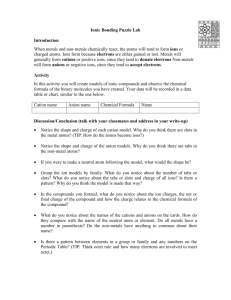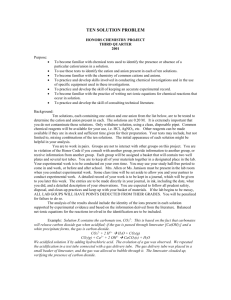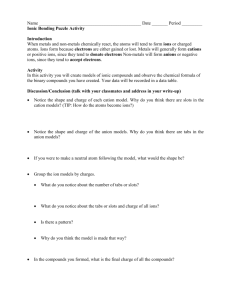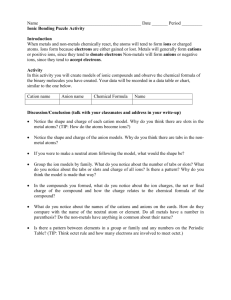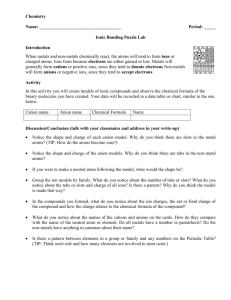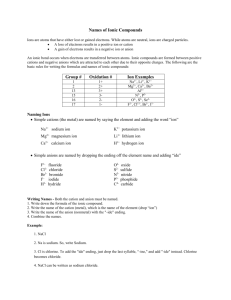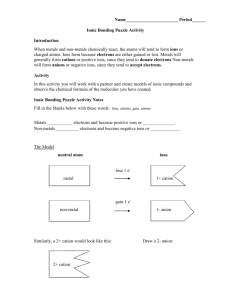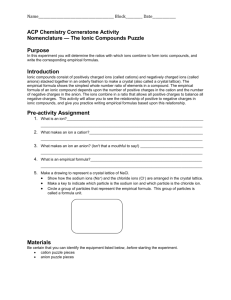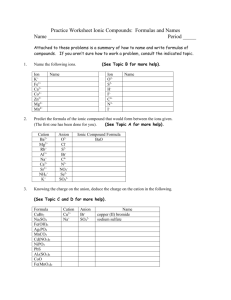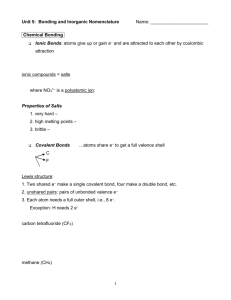Ionic Bonding Model Cards
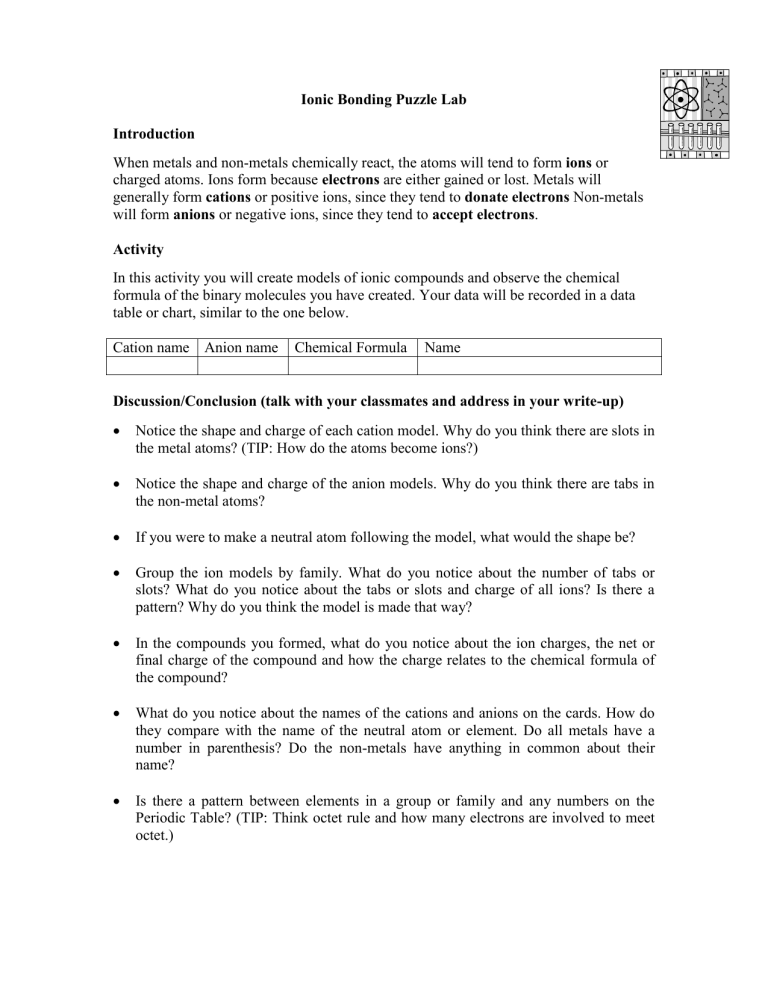
Ionic Bonding Puzzle Lab
Introduction
When metals and non-metals chemically react, the atoms will tend to form ions or charged atoms. Ions form because electrons are either gained or lost. Metals will generally form cations or positive ions, since they tend to donate electrons Non-metals will form anions or negative ions, since they tend to accept electrons .
Activity
In this activity you will create models of ionic compounds and observe the chemical formula of the binary molecules you have created. Your data will be recorded in a data table or chart, similar to the one below.
Cation name Anion name Chemical Formula Name
Discussion/Conclusion (talk with your classmates and address in your write-up)
Notice the shape and charge of each cation model. Why do you think there are slots in the metal atoms? (TIP: How do the atoms become ions?)
Notice the shape and charge of the anion models. Why do you think there are tabs in the non-metal atoms?
If you were to make a neutral atom following the model, what would the shape be?
Group the ion models by family. What do you notice about the number of tabs or slots? What do you notice about the tabs or slots and charge of all ions? Is there a pattern? Why do you think the model is made that way?
In the compounds you formed, what do you notice about the ion charges, the net or final charge of the compound and how the charge relates to the chemical formula of the compound?
What do you notice about the names of the cations and anions on the cards. How do they compare with the name of the neutral atom or element. Do all metals have a number in parenthesis? Do the non-metals have anything in common about their name?
Is there a pattern between elements in a group or family and any numbers on the
Periodic Table? (TIP: Think octet rule and how many electrons are involved to meet octet.)
Ionic Bonding Model Lab Scoring Rubric
1
4
3
2
Lab format follows the expected guidelines in the handout: “Downs Laboratory
Report Format.”
Get document from homework link at CHS homepage.
Data is organized into a table with the names of cation, anion, chemical formula and compound name.
Discussion and Conclusion addresses:
Explain how the model relates to the ion; number and shape of slot, (ie. charge, cation, anion), what a neutral atom would look like in the model.
Explain how elements are organized on the Periodic Table of Elements
(i.e the category; metal or non-metal; and charge of the ion; amount of charge and position on the Periodic Table of Elements related to the valence electrons.
Explain the connection between the ion charge and the ratio of atoms in the chemical formula for the ionic compound (the pieces fit together to balance charge)
Identify the similarity in the name for all non-metal anions, similarity in the name for Alkai Metal and Alkaline Earth Metal cations; similarity in the name for all other metal cations.
Lab format follows the guidelines in the handout. Blank page on left for scores
Data does not have 40 combinations, cation name, anion name, charge chemical symbol, and chemical name
Missing some topics in the discussion or there is some incorrect information in parts of Discussion/Conclusion or data table.
Formatting problem
Conceptual errors when writing chemical formula or name of compounds
Missing or incorrect information in many parts of the Discussion/Conclusion
Major problems or conceptual errors.
Ionic Bonding Puzzle Lab Notes
The Model
Metals ___________ electrons and become positive ions or ______________.
Non-metals __________ electrons and become negative ions or _____________. lose, cations, gain, anions
neutral atom electron ions
metal
non-metal
Using the same analogy for the atom, what would a +2 cation and a -2 anion look like?
Bonding and Predicting Chemical Formulas
Al
2
O
3
The ______________ show the ___________ of each atom in the ________________. subscripts, ratio, compound
For an ionic bond, the ________ need to balance _____________. The _____________ of each ion changes to make the compound _____________. The chemical ___________ shows how many of each ion are needed to _____________ the ____________ and make the compound neutral.
Ions, charge, number, neutral, formula, balance
What ratio will the +1 and -1 ions combine to balance the charge?
+
What ratio will the +2 and -1 ions combine to balance the charge?
+
Naming or Nomenclature : Compound name is directly from the Ion names
Use the name on the puzzle pieces to determine the name of each compound you created.
TIP : In this lab only create binary compounds to keep things simple.
DEF. - Binary compound:
What do all of the Type II cations have in common?
DEF. – Type II cation:
Type Charge
Other
What does the Roman Numeral show for a Type II ion?
How is a Type II cation named?
Notice the Type ____ cations do not have a Roman Numeral. What are the charges of an ion formed from a Type I metal?
What is the connection between Group number and Type 1 cation charge?
What do all ________ atomic non-metals or _______________ have in common?
Type Charge mono-, anions
Name
Other?
What is the connection between Group number and monatomic anion charge?
Computer TIP : To make a subscript for a chemical formula, highlight the number and from the menu bar, select Format > Font > Subscript or A
2
on the Font Formatting Pallette
Y +3
Yttrium(III)
Fe +3
Iron(III)
Fe +2
Iron(II)
Li +1
Lithium
Li +1
Lithium
Li +1
Lithium
Na +1
Sodium
Na +1
Sodium
F -1
Fluoride
F -1
Fluoride
Cl -1
Chloride
Cl -1
Chloride
Br -1
Bromide
Br -1
Bromide
-1 Anion
Wildcard
Na +1
Sodium
K +1
Potassium
K +1
Potassium
K +1
Potassium
Ca +2
Calcium
+2 Cation
Wildcard
-3 Anion
Wildcard
+1 Cation
Wildcard
O -2
Oxide
I -1
Iodide
-2 Anion
Wildcard
Ti +4
Titanium (IV)
O -2
Oxide
I -1
Iodide
Mg +2
Magnesium
N -3
Nitride
P -3
Phosphide
Ag +1
Silver
Cu +1
Copper(I)
S -2
Sulfide
Mg +2
Magnesium
Ca +2
Calcium
Cu +2
Copper(II)
Al +3
Aluminum
